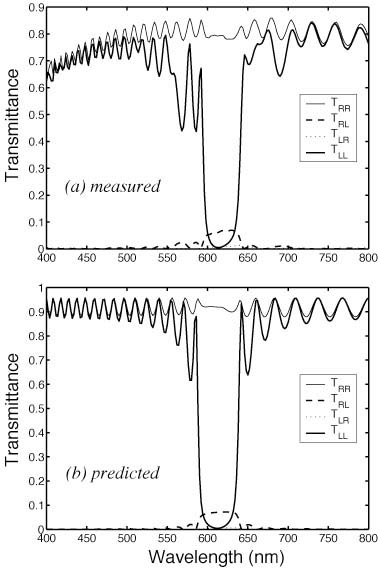
The Pennsylvania State University
Department of Engineering Science and Mechanics
Joseph B. Geddes III and Akhlesh Lakhtakia
A chiral sculptured thin film (STF) must display the circular Bragg phenomenon in accordance with its periodic nonhomogeneity along its helicoidal axis.
Briefly, a structurally left-handed chiral STF only a few periods thick almost completely reflects axially incident, left-circularly polarized (LCP) light with wavelength lying in the Bragg regime; while the reflection of axially incident, right-circularly polarized (RCP) light in the same regime is very little.
The bandwidth of the Bragg regime and the peak reflectivity therein first increase with the thickness of the chiral STF, and then saturate. Once this saturation has occurred, further thickening of the film has negligible effects on the reflection spectrum in the vicinity of the Bragg regime.
The measured and predicted transmittance spectrums of a structurally left-handed chiral STF are shown in the figure below.

Q. Wu, I. J. Hodgkinson and A. Lakhtakia, "Circular polarization filters made of chiral sculptured thin films: experimental and simulation results," Opt. Engg. 39, 1863-1868 (2000)
The spatiotemporal anatomy of the circular Bragg phenomenon has recently been uncovered.
The time-domain Maxwell curl postulates were solved for an incident pulse modulating a circularly polarized carrier plane wave, after adopting a Lorentzian model for the permittivity tensor.
A pulse bleeding phenomenon occurs, when the handednesses of the carrier wave and the chiral STF coincide and the carrier wavelength is in the vicinity of the center-wavelength of the Bragg regime.
The handedness-sensitive phenomenon is delicately balanced with respect to the carrier wavelength and the material periodicity.
Suppose the chiral STF is structurally right-handed, and the wavelength of the RCP carrier wave coincides with the center-wavelength of the Bragg regime. The incident and the refracted pulses are then connected by a light pipe that transports energy from the refracted pulse to the reflected pulse. The refracted pulse loses energy for two reasons: (i) attenuation as it propagates, and (ii) bleeding due to the light pipe. The bleeding diminishes as the overlap of the pulse spectrum and the Bragg regime decreases, and it is absent when the carrier wave is LCP.
| Quicktime Movie | Geddes and Lakhtakia, Microw. Opt. Technol. Lett. 28, 59-62 (2001) | Quicktime Movie | Geddes and Lakhtakia, Eur. Phys. J. AP 13, 3-14 (2001) | Quicktime Movie | Geddes and Lakhtakia, Eur. Phys. J. AP 13, 3-14 (2001) | Quicktime Movie | Geddes and Lakhtakia, Journal Vol, pp (2002) | Quicktime Movie | Geddes and Lakhtakia, Journal Vol, pp (2002) |
|
Quicktime Movie
|
Geddes and Lakhtakia, Optik
112, 62-66 (2001)
| | Quicktime Movie | Geddes and Lakhtakia, Opt. Commun, 182, 45-57 (2000) | Quicktime Movie | Geddes and Lakhtakia, Opt. Commun, 182, 45-57 (2000) |